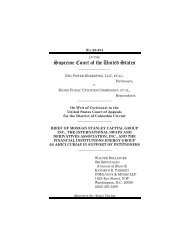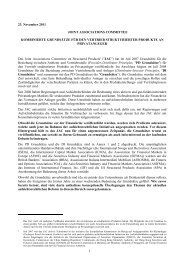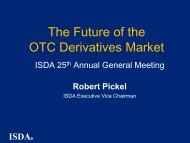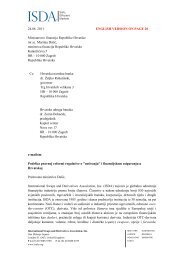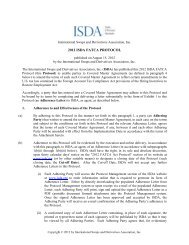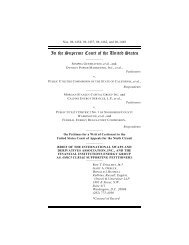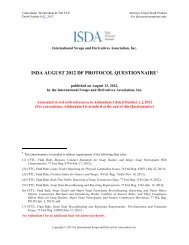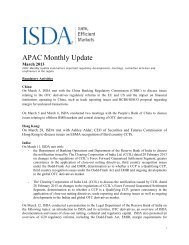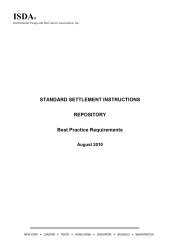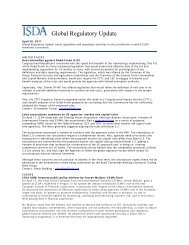ISDA Margin Survey 2013
ISDA Margin Survey 2013
ISDA Margin Survey 2013
Create successful ePaper yourself
Turn your PDF publications into a flip-book with our unique Google optimized e-Paper software.
<strong>ISDA</strong> <strong>Margin</strong> <strong>Survey</strong> <strong>2013</strong><br />
June <strong>2013</strong><br />
<strong>ISDA</strong>’s annual <strong>Margin</strong> <strong>Survey</strong> provides information about the use of collateral in the OTC derivatives<br />
business. The data used in the <strong>2013</strong> <strong>Margin</strong> <strong>Survey</strong> is sampled as of December 31, 2012. Over the past<br />
13 years, the <strong>Margin</strong> <strong>Survey</strong> has provided a consistent set of benchmarks for collateral use, and is part<br />
of a broader set of <strong>ISDA</strong> initiatives in the area of collateral, including documentation, best practices<br />
and practitioner guidelines.<br />
www.isda.org<br />
© <strong>2013</strong> International Swaps and Derivatives Association, Inc. All rights reserved. Brief excerpts may be reproduced or translated provided the source is stated.
INTERNATIONAL SWAPS AND DERIVATIVES ASSOCIATION<br />
1<br />
Information about <strong>ISDA</strong> and its activities is available on the Association's web site: www.isda.org.<br />
Since its founding in 1985, the International Swaps and Derivatives Association has worked to make over-thecounter<br />
(OTC) derivatives markets safe and efficient.<br />
<strong>ISDA</strong>’s pioneering work in developing the <strong>ISDA</strong> Master Agreement and a wide range of related documentation<br />
materials, and in ensuring the enforceability of their netting and collateral provisions, has helped to significantly<br />
reduce credit and legal risk. The Association has been a leader in promoting sound risk management practices<br />
and processes, and engages constructively with policymakers and legislators around the world to advance the<br />
understanding and treatment of derivatives as a risk management tool.<br />
Today, the Association has more than 800 member institutions from 60 countries on six continents. These<br />
members include a broad range of OTC derivatives market participants: global, international and regional banks,<br />
asset managers, energy and commodities firms, government and supranational entities, insurers and diversified<br />
financial institutions, corporations, law firms, exchanges, Clearinghouses and other service providers.<br />
<strong>ISDA</strong>’s work in three key areas – reducing counterparty credit risk, increasing transparency, and improving the<br />
industry’s operational infrastructure – show the strong commitment of the Association toward its primary goals;<br />
to build robust, stable financial markets and a strong financial regulatory framework.<br />
Information about <strong>ISDA</strong> and its activities is available on the Association's web site: www.isda.org.<br />
SAPIENT GLOBAL MARKETS<br />
Sapient were contracted by <strong>ISDA</strong> to serve as consultants to the <strong>2013</strong> <strong>Margin</strong> <strong>Survey</strong> and were responsible for the<br />
collection and aggregation of the individual data submissions. Sapient Global Markets, a division of Sapient®<br />
(NASDAQ: SAPE), is a leading global provider of business and technology services for capital and commodity<br />
market participants, intermediaries and regulators. It provides strategy and advisory services, design and<br />
implementation of advanced technology solutions, and delivery through a proven, globally distributed model.<br />
Sapient Global Markets helps its clients optimize and transform their business processes, capitalize on business<br />
and operational opportunities, adapt to regulatory mandates, and foster business innovation and growth. The<br />
company operates in key financial and commodity centres in Europe, North America and Asia.<br />
For more information, visit: www.sapientglobalmarkets.com.<br />
<strong>ISDA</strong> <strong>Margin</strong> <strong>Survey</strong> <strong>2013</strong> June <strong>2013</strong>
SUMMARY<br />
2<br />
1. Collateral in circulation in the non-cleared OTC derivatives market rose 1 percent during 2012, from US$ 3.65<br />
trillion at end-2011 to US $ 3.70 trillion as at December 31, 2012.<br />
2. The number of active collateral agreements (those with exposure and / or collateral balances) supporting<br />
non-cleared OTC derivatives transactions was 118,853 at end-2012, of which 87 percent are <strong>ISDA</strong><br />
agreements. About 88 percent of all collateral agreements are bilateral, an increase of 4 percentage points<br />
over last year.<br />
3. 87.4 percent of all collateral agreements are with counterparties whose portfolios of collateralized<br />
transactions include less than 100 OTC derivatives. 0.4 percent of all collateral agreements are with<br />
counterparties whose portfolios of collateralized transactions include more than 5000 trades.<br />
4. Among all firms responding to the survey, 73.7 percent of all OTC derivatives trades (cleared and noncleared)<br />
are subject to collateral agreements. For large firms, the figure is 80.7 percent.<br />
5. Responding firms also reported that 69.1 percent of all non-cleared trades are subject to collateral<br />
agreements. For large firms, the figure is 75.3 percent.<br />
6. On an asset class basis, 83.0 percent of all CDS transactions (79.4 percent of non-cleared) and 79.2 percent of<br />
all fixed income transactions (72.5 percent of non-cleared) are subject to collateral agreements. For large<br />
firms, the figures are 96.3 and 89.4 percent, respectively (and are 94.5 percent and 74.9 percent,<br />
respectively, for non-cleared).<br />
7. Portfolio reconciliation, which refers to the matching of the population, trade economics and mark-to-market<br />
of outstanding trades in a collateralized portfolio, is widely used and considered best market practice. For all<br />
firms in <strong>2013</strong>, the survey evidences a clear effort to increase the frequency of portfolio reconciliation.<br />
8. With respect to collateral types, cash used as collateral represents 79.5 percent of collateral received and<br />
78.7 percent of collateral delivered, which is an increase from 78.8 and 75.6 percent respectively last year.<br />
Government securities constitute 11.6 percent of collateral received and 18.4 percent of collateral delivered<br />
this year, consistent with last year’s results.<br />
<strong>ISDA</strong> <strong>Margin</strong> <strong>Survey</strong> <strong>2013</strong> June <strong>2013</strong>
1. INTRODUCTION<br />
3<br />
<strong>ISDA</strong>’s annual <strong>Margin</strong> <strong>Survey</strong>, first published in 2000, provides information about the use of collateral in the OTC<br />
derivatives business. The data used in the <strong>2013</strong> <strong>Margin</strong> <strong>Survey</strong> is sampled as of December 31, 2012. Over the<br />
past 13 years, the <strong>Margin</strong> <strong>Survey</strong> has provided a consistent set of benchmarks for collateral use. Each year the<br />
<strong>Margin</strong> <strong>Survey</strong> evolves slightly to reflect market developments, and thus in the <strong>2013</strong> <strong>Survey</strong> more attention is<br />
paid to collateralization of cleared derivatives, in addition to coverage of the bilateral, non-cleared market. The<br />
<strong>Margin</strong> <strong>Survey</strong> is part of a broader set of <strong>ISDA</strong> initiatives in the area of collateral, including documentation, best<br />
practices and practitioner guidelines. All amounts reported are in US dollars.<br />
Sapient served as consultants to this year’s <strong>Margin</strong> <strong>Survey</strong>; the consultants collected and aggregated individual<br />
responses to the <strong>Survey</strong>. All data obtained from <strong>Survey</strong> responses were kept in strict confidence. Access by<br />
<strong>ISDA</strong> and Sapient staff is strictly limited, and the data is not shared with employees of other member firms or<br />
with any other outside party.<br />
Please note that there are various proposed and final regulations implementing the Dodd-Frank Act and EMIR in<br />
regard to collateral management. The results of this survey reflect data gathered prior to the implementation of<br />
these new regulatory requirements.<br />
1.1. COLLATERAL AS A RISK MANAGEMENT TOOL<br />
Credit risk exists in the OTC derivatives market whenever a counterpart to a transaction has an obligation to<br />
make payments or deliveries in the future. As discussed in numerous <strong>ISDA</strong> publications, there are several<br />
methods of addressing the credit risk arising from a derivatives transaction, including: holding capital against the<br />
exposure, reducing credit risk through close-out netting; having another person or entity reimburse losses<br />
through financial guarantees; or by collateralizing the exposure 1 . Each of these methods has its advantages and<br />
disadvantages.<br />
The decision to use collateral to mitigate risk is one evaluated carefully by credit risk managers in each firm that<br />
is a counterparty to a derivative transaction. This discretionary, prudential management of credit risk, which<br />
may include the use of collateral, is a common feature across a wide range of products in the capital and retail<br />
financial markets, including loans, derivatives, clearance and other types of transactions.<br />
Collateralization works best in those cases where the volume of activity is sufficient to warrant bearing the<br />
operational and procedural burdens associated with the sophisticated collateral process, provided that a legally<br />
enforceable claim can be established against collateral. Therefore, there are cases where it is simply more cost<br />
efficient or legally effective to rely on other methods of credit risk mitigation. Nonetheless, collateralization<br />
remains among the most widely used methods of mitigating counterparty credit risk in the OTC derivatives<br />
market, and market participants have increased their reliance on collateralization over the years. In an evolving<br />
regulatory environment that broadly seeks to reduce the counterparty risk associated with derivatives, the<br />
continued use of bilateral collateralization has an important role to play in risk mitigation.<br />
1 <strong>ISDA</strong>’s “Market Review of OTC Derivative Bilateral Collateralization Practices” can be found on <strong>ISDA</strong>’s website at<br />
www.isda.org.<br />
<strong>ISDA</strong> <strong>Margin</strong> <strong>Survey</strong> <strong>2013</strong> June <strong>2013</strong>
1.2. ABOUT THE SURVEY RESPONDENTS<br />
4<br />
A total of 78 <strong>ISDA</strong> member firms responded to the <strong>2013</strong> <strong>Margin</strong> <strong>Survey</strong>; Appendix 1 lists the respondents.<br />
Respondents are classified into three size groups based on the number of active collateral agreements. The<br />
threshold for classification as a "large" program is more than 3,000 active agreements. Respondents were<br />
classified as having medium-sized programs if they had more than 100 but less than 3,000 active collateral<br />
agreements outstanding. Firms that reported having between zero and 100 active agreements were classified<br />
as having small programs. For the <strong>2013</strong> <strong>Survey</strong>, 14 of the respondents were classified as large firms, 33 were<br />
classified as medium, and 31 were classified as small firms.<br />
Comparison of 2012 and <strong>2013</strong> results in tables 1.1 and 1.2 show a clear increase in the number of respondents,<br />
with 27 more in this year’s survey, of which 20 were banks / broker dealers. Likely causes of an increase of<br />
respondents include preparation for pending regulatory reform. Of the 78 firms that participated in <strong>2013</strong> 40<br />
also participated in 2012.<br />
Table 1.1: Profile of firms responding to the <strong>2013</strong> <strong>ISDA</strong> <strong>Margin</strong> <strong>Survey</strong><br />
Number of respondents<br />
Size Class<br />
Number of<br />
agreements<br />
Number of<br />
respondents <strong>2013</strong><br />
Number of<br />
respondents 2012<br />
Large >3,000 14 14<br />
Medium 100 - 3,000 33 23<br />
Small 0 - 100 31 14<br />
Total 78 51<br />
Table 1.2 classifies respondents according to firm or entity type; 63 of the 78 respondents were banks and<br />
broker-dealers. The remaining participants consisted of hedge funds, insurers, government agencies and<br />
government-sponsored entities.<br />
Table 1.2: Type of entity responding to the <strong>2013</strong> <strong>ISDA</strong> <strong>Margin</strong> <strong>Survey</strong><br />
Number of respondents<br />
Type of entity <strong>2013</strong> 2012<br />
Bank 63 43<br />
Asset Manager 5 1<br />
Hedge Fund 2 1<br />
Energy Trading Firm 1 1<br />
Insurer 2 2<br />
Other 5 3<br />
Total 78 51<br />
<strong>ISDA</strong> <strong>Margin</strong> <strong>Survey</strong> <strong>2013</strong> June <strong>2013</strong>
5<br />
Chart 1.1 shows the geographic distribution of survey respondents. 51 percent of institutions were based in<br />
Europe, the Middle East or Africa and 32 percent were based in the Americas.<br />
Chart 1.1: Geographic Distribution of <strong>Survey</strong> Respondents<br />
<strong>ISDA</strong> <strong>Margin</strong> <strong>Survey</strong> <strong>2013</strong> June <strong>2013</strong>
2. COLLATERAL ASSETS<br />
6<br />
2.1. ESTIMATES OF TOTAL COLLATERAL OUTSTANDING FOR NON-CLEARED OTC TRANSACTIONS<br />
The reported amount of collateral in circulation, the collateral balances held or posted that have been received<br />
or delivered (respectively) by two counterparts to an OTC derivatives contract, in the non-cleared OTC<br />
derivatives market at the end of 2012 was approximately $2.67 trillion, which is up over 8 percent from last<br />
year's estimated amount of $2.46 trillion. Collateral in circulation is the total collateral received and delivered<br />
against non-centrally cleared transactions and is a useful indicator of the total amount of collateral used to<br />
mitigate the credit risk of OTC derivatives.<br />
The $3.7 trillion estimate of total collateral in circulation is based on a total reported collateral amount of $2.67<br />
trillion; the estimation procedure to derive the collateral in circulation value from the reported collateral<br />
amount is described in Appendix 2. Measured over the past 14 years, the growth in estimated collateral in<br />
circulation has remained relatively consistent, resulting in a compound annual growth rate of 23 percent.<br />
It is interesting to note that the overall level of collateral in circulation has remained essentially static year on<br />
year, even though more business is now being cleared, and is thus excluded from the results reported here,<br />
suggesting continued underlying growth in the collateralization of bilateral OTC derivatives. Additionally, the<br />
levels of bilaterally compressed transactions continued on a regular basis through 2012 with more than $48.7<br />
trillion in Interest Rate Derivatives and Credit Derivatives compressed on a net basis 2 . Compression involves the<br />
tearing up of matched trades or trades that do not contribute risk to a dealer’s portfolio. In recent years, the<br />
large volume of cleared trades that have been compressed has worked to reduce the percentage of the OTC<br />
derivatives market that has been cleared. As with IRS, compression of cleared CDS trades leads to a significant<br />
reduction in the percent of CDS that remain open in a cleared state. <strong>ISDA</strong> believes that this effect has been<br />
particularly dramatic in the CDS space as the instruments have become completely standardized following the<br />
Big Bang and Small Bang protocols in 2009, and thus are able to be compressed very efficiently. Furthermore,<br />
clearinghouses that clear CDS have an active program of compressing cleared trades. For example, ICE reports<br />
that the gross notional amount of transactions cleared from the commencement of clearing in 2009 through<br />
June 29, 2012, is approximately $31.2 trillion. If compression had not occurred, <strong>ISDA</strong> estimates that a<br />
significantly greater percentage of CDS would continue to exist in clearinghouses, increasing the percentage of<br />
the market that is cleared. For CDS, compression continues to reduce operational risk and enables more efficient<br />
management of capital requirements 3 .<br />
2 Sources: TriOptima, Markit/ICE<br />
3 Source: <strong>ISDA</strong> Mid-Year 2012 Market Analysis<br />
<strong>ISDA</strong> <strong>Margin</strong> <strong>Survey</strong> <strong>2013</strong> June <strong>2013</strong>
Chart 2.1: Growth in value of reported and estimated collateral (USD billions) as at December 31, 2012<br />
7<br />
Chart 2.2 below displays data on aggregate counterparty credit exposure collected by the Bank for International<br />
Settlements (BIS). The data reflects the net mark-to-market value of counterparty exposures, taking into<br />
account the benefits of close-out netting, but before taking into account the effect of collateral in reducing risk<br />
exposure. As the chart shows, aggregate counterparty exposure peaked at US $5,005 trillion in December of<br />
2008 but has now fallen to US $3,668 trillion in December 2012.<br />
When comparing the recent figures from Charts 2.1 and 2.2 it is interesting to note an 8 percent decline in<br />
counterparty credit exposure in 2012 but an 8 percent increase of reported collateral in circulation. This<br />
suggests that more exposure is being collateralized.<br />
When compared over a greater length of time, the data underlying these two charts reveals a trend toward a<br />
steady increase in collateral in circulation. Over the period from 2002 through 2012 the amount of reported<br />
collateral in circulation has grown at a 17 percent compounded annual growth rate while gross credit exposure,<br />
as measured by the BIS, has grown at a 10 percent compounded annual rate.<br />
<strong>ISDA</strong> <strong>Margin</strong> <strong>Survey</strong> <strong>2013</strong> June <strong>2013</strong>
Chart 2.2: Gross Credit Exposure of OTC Derivatives (USD billions) as at June, 30, 2012<br />
8<br />
Source: Bank for International Settlements<br />
2.2. TYPES OF ASSETS USED AS COLLATERAL<br />
Table 2.1 shows the breakdown of reported collateral by asset category. The use of cash and government<br />
securities as collateral remains predominant, constituting 91.1 percent of collateral received and 97.1 percent of<br />
collateral delivered, as would be expected given the recent focus on collateral quality and counterparty risk.<br />
The use of cash collateral alone remains very high, consistently around 80 percent for the past several years.<br />
Historically it is believed that this empirical preference for cash arose as a result of the operational simplicity<br />
associated with cash collateral, but increasingly the decision is driven by economic considerations:<br />
<br />
<br />
<br />
The development of a large cleared market for OTC derivatives, primarily between dealers, for which<br />
Variation <strong>Margin</strong> is required in cash.<br />
The importance of aligning collateral flows with future swap cashflows, so that the collateral effectively<br />
funds the future cashflows with minimized currency and basis risk; this is one of the underlying reasons<br />
behind <strong>ISDA</strong>’s development of the Standard Credit Support Annex (SCSA), which like the cleared market<br />
requires Variation <strong>Margin</strong> to be cash only.<br />
The increasing importance of maintaining economic consistency across the cleared and non-cleared<br />
parts of the swap market, which is facilitated by the use of cash collateral, as well as collateral<br />
arrangements such as the SCSA which produce bilateral collateralization economics which are essentially<br />
identical to those that apply in cleared venues for Variation <strong>Margin</strong>.<br />
<strong>ISDA</strong> <strong>Margin</strong> <strong>Survey</strong> <strong>2013</strong> June <strong>2013</strong>
9<br />
The low interest rate environment means that cash is, often, the cheapest-to-deliver form of collateral<br />
under most collateral agreements.<br />
Table 2.1: Value of collateral received and delivered by respondents against non-cleared OTC transactions<br />
USD millions<br />
Cash<br />
Government<br />
Securities<br />
Collateral Received Percentage Collateral Delivered Percentage<br />
Type of Collateral <strong>2013</strong> 2012 <strong>2013</strong> 2012 <strong>2013</strong> 2012 <strong>2013</strong> 2012<br />
USD 419,710 436,018 29.5% 33.0% 357,792 357,219 28.8% 31.3%<br />
EUR 627,725 537,450 44.2% 40.8% 537,440 438,191 43.2% 38.4%<br />
GBP 34,073 23,871 2.4% 1.8% 40,379 29,316 3.2% 2.6%<br />
JPY 34,736 27,222 2.4% 2.1% 26,322 25,267 2.1% 2.2%<br />
Other 14,357 14,988 1.0% 1.1% 16,670 11,722 1.3% 1.1%<br />
Subtotal 1,130,602 1,039,549 79.5% 78.8% 978,603 861,715 78.7% 75.6%<br />
United States 54,673 60,926 3.8% 4.6% 78,724 78,974 6.3% 6.9%<br />
European Union 31,471 30,733 2.2% 2.3% 92,410 109,677 7.4% 9.6%<br />
United Kingdom 21,286 13,459 1.5% 1.1% 20,861 22,736 1.7% 2.0%<br />
Japan 37,293 33,064 2.6% 2.5% 30,056 22,738 2.4% 2.0%<br />
Other 19,841 13,869 1.4% 1.1% 7,338 7,237 0.6% 0.7%<br />
Subtotal 164,563 152,051 11.6% 11.6% 229,389 241,362 18.4% 21.2%<br />
Others<br />
Government agency securities<br />
/ GSEs<br />
31,223 28,607 2.2% 2.2% 15,356 12,861 1.2% 1.1%<br />
Supranational Bonds 1,044 1,090 0.1% 0.1% 2,112 2,139 0.2% 0.2%<br />
US Municipal Bonds 4,225 1,789 0.3% 0.1% 29 0 0.0% 0.0%<br />
Covered Bonds 3,187 914 0.2% 0.1% 2,277 2,097 0.2% 0.2%<br />
Corporate Bonds 34,904 40,711 2.5% 3.1% 8,437 13,090 0.7% 1.1%<br />
Letters of Credit 6,138 9,125 0.4% 0.7% 728 0 0.1% 0.0%<br />
Equities 31,809 24,815 2.2% 1.8% 4,748 902 0.4% 0.1%<br />
Metals and Other<br />
Commodities<br />
34 148 0.0% 0.0% 0 0 0.0% 0.0%<br />
Other 13,976 19,661 1.0% 1.5% 2,505 5,997 0.2% 0.5%<br />
Subtotal 126,541 126,860 8.9% 9.6% 36,193 37,086 2.9% 3.2%<br />
Total Collateral 1,421,706 1,318,460 1,244,185 1,140,163<br />
<strong>2013</strong> 2012<br />
Grand Total (Received and<br />
Delivered) 2,665,890 2,458,623<br />
Note: Collateral Received differs from Collateral Delivered because <strong>Survey</strong> results are not based on the responses of all firms engaged in<br />
collateralized derivatives transactions.<br />
2.3. TREATMENT OF COLLATERAL DELIVERED FOR NON-CLEARED OTC TRANSACTIONS<br />
The <strong>2013</strong> <strong>Survey</strong> contains several questions regarding the treatment of collateral received and delivered to meet<br />
exposures from non-cleared OTC transactions. The first of these questions asked whether respondents had<br />
made arrangements to segregate collateral posted as Independent Amounts (“IA”) and what types of<br />
arrangements were made to secure that collateral. The second asked whether respondents rehypothecate or<br />
<strong>ISDA</strong> <strong>Margin</strong> <strong>Survey</strong> <strong>2013</strong> June <strong>2013</strong>
10<br />
re-use collateral, and what percentage of collateral received in connection with OTC derivatives transactions is<br />
rehypothecated.<br />
Table 2.2 below summarizes responses to the question of where IA is held. IA is analogous to initial margin<br />
required by futures clearinghouses to collateralize potential counterparty exposures. Like initial margin, IA is<br />
designed to protect against the gap risk that may arise between margin calls 4 . It should be noted that although<br />
the terms “Independent Amount” (bilateral) and “Initial <strong>Margin</strong>” (clearing) can be thought of as equivalent and<br />
are often used interchangeably in the market, this superficial equivalence should not give the impression that<br />
they are calibrated similarly. To the contrary, IA and IM exist in two totally different contexts: IA provides<br />
protection against default loss in conjunction with bilateral Variation <strong>Margin</strong> and regulatory capital; whereas IM<br />
provides protection in conjunction with clearinghouse Variation <strong>Margin</strong> and the rest of the clearinghouse<br />
“waterfall” 5 .<br />
<strong>Survey</strong> respondents reported that most of the Independent Amount is not segregated, with 64.9 percent of IA<br />
received and 69.2 percent of IA delivered being comingled with variation margin. Holding of IA and variation<br />
margin together continues to be industry standard both contractually and operationally. However, although<br />
segregation of IA is not currently mandated within regulation (the Dodd Frank Act in the US and proposals in<br />
Europe provide that segregation should be offered to clients), it is interesting to note that the ability to<br />
segregate has been made increasingly available to counterparties over the past years on a voluntary basis, and<br />
has led to adoption of 35.1 percent of IA received and 30.8 percent of IA delivered being segregated in some<br />
respect. Respectively, this is an increase of 8.9 and 3.0 percentage points over last year’s results of 26.2 and 27.8<br />
percent.<br />
Since IA segregation has been offered by firms on a voluntary basis for several years at this point, this suggests<br />
that as market participants have evaluated the balance of risks and costs inherent in over-collateralization (as IA<br />
and IM both create) only about one-third have elected to bear the additional cost of segregation in preference<br />
to managing the additional risk of over-collateralization. This is interesting in the context of forthcoming margin<br />
regulation which may dramatically increase the amount of IA, and mandate the offering of segregation.<br />
4 <strong>ISDA</strong> released an Independent Amount Whitepaper that contains a comprehensive analysis of the issues surrounding<br />
Independent Amounts. See, "Independent Amounts," <strong>ISDA</strong> (March 1, 2010), at www.isda.org.<br />
5 The waterfall of protections against default impacting a clearing house is: (a) Variation <strong>Margin</strong>, (b) Initial <strong>Margin</strong> of the<br />
client, (c) Initial <strong>Margin</strong> of other clients in some CCP models, but not all, (d) the Member Default Fund of the clearing house,<br />
(e) the capital of the clearing house itself, and (f) the proceeds from a cash call made on member firms of the clearing<br />
house. Note, this is a generalized waterfall description - specific elements and sequence will differ from one CCP to<br />
another.<br />
<strong>ISDA</strong> <strong>Margin</strong> <strong>Survey</strong> <strong>2013</strong> June <strong>2013</strong>
Table 2.2: Treatment of Independent Amount<br />
Percentage of total collateral amount<br />
Independent Amount Independent Amount<br />
Received<br />
Delivered<br />
All Large All Large<br />
Commingled with variation margin 64.9% 64.0% 69.2% 63.9%<br />
Segregated on books and records of dealer or affiliate 7.6% 7.9% 21.8% 27.8%<br />
Segregated with custodian (excluding Tri-Party<br />
arrangements)<br />
11.2% 10.8% 4.7% 3.7%<br />
Segregated with Tri-party Arrangement 16.3% 17.2% 4.3% 4.5%<br />
11<br />
2.4. COLLATERAL RE-USE<br />
The practice of collateral re-use involves the re-pledging/re-delivery, sale, investment, or other contractuallypermitted<br />
use of collateral received by a party. All collateral received under title transfer forms of collateral<br />
agreement has the intrinsic property of being re-usable, because title to the asset has been transferred.<br />
Collateral received under security interest forms of collateral agreement may have the right of re-use (called<br />
“rehypothecation”), but this must be granted as a right by the delivering party; <strong>ISDA</strong> CSAs generally include this<br />
right of re-use unless the parties specifically remove it. Collateral re-use is very common across the industry and<br />
is of importance in both the reduction of collateral funding costs and ensuring that the global supply of high<br />
quality collateral assets is not overwhelmed by demand, thus driving up prices for such assets.<br />
Table 2.3: Percentage of collateral re-used<br />
Percentage posted in connection with OTC derivatives transactions that is eligible to be re-used under the terms of the<br />
collateral agreements<br />
Large, Medium, Small,<br />
Average Average Average<br />
Cash 92.7% 83.2% 66.5%<br />
Securities 57.8% 75.7% 40.3%<br />
Other 19.9% 16.9% 4.5%<br />
Total 82.0% 77.9% 64.7%<br />
Percentage posted in connection with OTC derivatives transactions that is actually re-used under the terms of the collateral<br />
agreements<br />
Large, Medium, Small,<br />
Average Average Average<br />
Cash 88.5% 69.4% 42.4%<br />
Securities 42.1% 38.3% 7.0%<br />
Other 4.1% 8.0% 0.0%<br />
Total 75.2% 62.2% 40.1%<br />
In the <strong>2013</strong> <strong>Survey</strong>, there continues to be a significant proportion of cash being reused, particularly amongst<br />
large firms, with 88.5 percent of collateral posted being re-used (where 92.7 percent is eligible to be reused<br />
under the terms of the collateral arrangement).<br />
Collateral re-use practices are discussed more comprehensively in <strong>ISDA</strong>'s “Market Review of OTC Derivative<br />
Bilateral Collateralization Practices”, cited earlier.<br />
<strong>ISDA</strong> <strong>Margin</strong> <strong>Survey</strong> <strong>2013</strong> June <strong>2013</strong>
3. EXTENT OF COLLATERAL USE<br />
12<br />
3.1. NUMBER AND TYPES OF COLLATERAL AGREEMENTS (SUPPORTING NON-CLEARED OTC TRANSACTIONS)<br />
Respondents to the <strong>2013</strong> <strong>Margin</strong> <strong>Survey</strong> report 118,853 active 6 collateral agreements in place for non-cleared<br />
OTC transactions, compared with 137,869 in the 2012 <strong>Survey</strong>, a 14 percent decrease. There are a number of<br />
factors contributing to this reduction. These include counterparty consolidation whereby legacy collateral<br />
agreements are discontinued over time due to mergers, effort by firms to consolidate multiple agreement types<br />
for the same legal entity (where a credit support deed, annex and long form confirmation may, for example, be<br />
in place), the more prolific negotiation of CSAs to cover multiple entities, and a transition toward cleared<br />
transactions. As per table 2.1, there has been an increase in the reported collateral in circulation, and therefore<br />
it is unlikely that a reduction in active collateral agreements is reflective of reduced margining and collateral<br />
activity throughout the industry.<br />
Charts 3.1 and 3.2 show the split between unilateral and bilateral agreements and between <strong>ISDA</strong> CSA 7 and non-<br />
<strong>ISDA</strong> CSA agreements. Respondents report that approximately 77 percent of their <strong>ISDA</strong> CSAs and 88 percent of<br />
all agreements are bilateral. As in previous years, <strong>ISDA</strong> CSA documentation is the most frequent choice among<br />
practitioners at about 87 percent. Non-<strong>ISDA</strong> CSA documents include bespoke margin agreements, long-form<br />
confirmations with collateral terms, master margining agreements, commodity-specific margining agreements,<br />
and jurisdiction-specific agreements such as French AFB and German Rahmenvertrag.<br />
Chart 3.1: Percentage and types of collateral agreements used by respondents: Bilateral vs. Unilateral<br />
6 Active collateral agreements are those with outstanding exposure and / or collateral balances.<br />
7 For these purposes we include <strong>ISDA</strong> Credit Support Annexes according to New York, English and Japanese laws, <strong>ISDA</strong><br />
Credit Support Deeds, and <strong>ISDA</strong> <strong>Margin</strong> Provisions.<br />
<strong>ISDA</strong> <strong>Margin</strong> <strong>Survey</strong> <strong>2013</strong> June <strong>2013</strong>
Chart 3.2: Percentage and types of collateral agreements used by respondents:<br />
Agreements<br />
13<br />
<strong>ISDA</strong> vs. Non-<strong>ISDA</strong><br />
3.2. COLLATERALIZATION LEVELS<br />
To measure collateral coverage, the <strong>Survey</strong> asked respondents to report percent of counterparty relationships<br />
covered by an active collateral agreement.<br />
Percent of trade volume is the number of OTC derivative trades subject to any collateral agreement divided by<br />
the total number of derivative trades. Tables 3.1 and 3.2 indicate the numbers of collateral agreements by<br />
portfolio trade count and by type of counterparty, respectively. Table 3.1 illustrates that 87.4 percent of all<br />
collateral agreements are with counterparties whose portfolios of collateralized transactions include less than<br />
100 OTC derivatives while 0.4 percent of all collateral agreements are with counterparties whose portfolios of<br />
collateralized transactions include more than 5,000 trades. Table 3.2 shows that mutual funds have the highest<br />
percentage (28.1 percent) of both bilateral and unilateral agreements across the various counterparty types<br />
while Special Purpose Vehicles (SPVs) have a total of 1.7 percent.<br />
Table 3.1: Percentage of collateral agreements by trade count in the portfolio<br />
Number of trades in the portfolio<br />
Percentage<br />
Greater than 5,000 trades 0.4%<br />
Between 2,500 and 5,000 trades 4.3%<br />
Between 500 and 2,499 trades 2.4%<br />
Between 100 and 499 trades 5.6%<br />
Less than 100 trades 87.4%<br />
Total 100.0%<br />
<strong>ISDA</strong> <strong>Margin</strong> <strong>Survey</strong> <strong>2013</strong> June <strong>2013</strong>
Table 3.2: Percentage of collateral agreement by counterparty type<br />
Counterparty Type<br />
Unilateral<br />
Percentage<br />
Bilateral<br />
Percentage<br />
Total<br />
Percentage<br />
Banks/Broker-dealers 1.4% 21.3% 22.7%<br />
Hedge funds 1.9% 14.7% 16.7%<br />
Mutual funds 1.2% 26.9% 28.1%<br />
Pension funds 0.1% 6.4% 6.5%<br />
Insurance companies 0.2% 3.1% 3.3%<br />
Energy/ Commodity firm 0.4% 1.7% 2.1%<br />
Non-financial corporations 2.3% 4.9% 7.2%<br />
Special purpose vehicles (SPV) 1.2% 0.5% 1.7%<br />
Supranationals 0.1% 0.2% 0.2%<br />
Government-sponsored entities/ Government Agencies 0.1% 0.9% 1.0%<br />
Sovereign national governments 0.1% 0.2% 0.3%<br />
Local or regional government entities 0.4% 0.7% 1.1%<br />
Other 2.1% 7.2% 9.2%<br />
Total 11.5% 88.5% 100.0%<br />
14<br />
Respondents were asked to indicate the number of collateralized agreements with live trades with regard to<br />
their total collateralized OTC derivatives trade population. An ‘inactive agreement’ is an executed agreement<br />
which has no current associated exposure and/or no collateral delivered or received as of December 31, 2012.<br />
The number of inactive agreements, which for this year’s survey was approximately 232,684, includes<br />
counterparties that still exist but do not currently trade under the existing agreement. Some of the inactive<br />
agreements do not have any current activity as at the end of the year but may be used to trade at some point.<br />
Generally speaking, firms use this number to benchmark the total number of agreements they have executed<br />
and gauge scalability.<br />
Table 3.3 shows the percent of all OTC derivatives trade volume (cleared and non-cleared) subject to credit<br />
support agreements by type of instrument. The results vary from a high of 83.0 percent of trade volume for<br />
credit derivatives to a low of 48.3 percent for commodities, including precious metals transactions for large<br />
firms. The relatively low rate of 52.0 percent for foreign exchange transactions is explained in part by the short<br />
maturities for most such transactions, which present relatively low risk and are often therefore not<br />
collateralized. Another factor is the heavy use of foreign exchange derivatives by non-financial companies, for<br />
which collateralization is not always required.<br />
<strong>ISDA</strong>’s 2009 Derivatives Usage <strong>Survey</strong> found that the use of foreign exchange derivatives and interest rate<br />
derivatives was almost universal among large multinational companies. Importantly, it should be noted that the<br />
nature of counterparty risk with short-dated FX trades is different to that generally associated with derivatives,<br />
being a settlement risk concern rather than an outright credit risk concern; accordingly the FX market has<br />
developed continuous-linked settlement methods of mitigating settlement risk, and these are widely used,<br />
highly effective, and not reported in this survey. Similarly, most users of commodity derivatives also tended to<br />
be non-financial companies, which are less likely to post collateral than financial firms 8 . It should be noted that<br />
the commodity derivatives market relies much more than other segments on letters of credit rather than<br />
financial collateral for counterparty risk protection, and these are not included in the reported numbers above.<br />
Thus, in interpreting this data, we note that not all OTC derivatives are alike, and sub-segments of the market<br />
8 See “2009 Derivatives Usage <strong>Survey</strong>”, in <strong>ISDA</strong> Research Notes (2009), No.2<br />
<strong>ISDA</strong> <strong>Margin</strong> <strong>Survey</strong> <strong>2013</strong> June <strong>2013</strong>
15<br />
are traded under different market conventions and have differing risk profiles, which in turn lead to differing<br />
degrees of collateralization for different types of transactions.<br />
Collateralization rates are uniformly higher among the large dealers than for the rest of the sample. Large<br />
dealers report that 80.7 percent of their overall trade volume is subject to collateral agreements with<br />
percentages ranging between 96.3 percent of their credit derivatives trades on the high end and 54.5 percent of<br />
commodity derivatives transactions on the low end (with the same caveat that letters of credit are excluded<br />
from this data, as was noted above).<br />
Table 3.3: Percentage of all trades subject to collateral agreements, by OTC derivatives product type<br />
All, Average Large, Average<br />
<strong>2013</strong> 2012 <strong>2013</strong> 2012<br />
Fixed Income Derivatives 79.2% 78.1% 89.4% 89.9%<br />
Credit Derivatives 83.0% 93.4% 96.3% 96.1%<br />
FX Derivatives 52.0% 55.6% 67.9% 70.6%<br />
Equity Derivatives 72.5% 72.7% 78.2% 85.3%<br />
Commodities, including precious metals 48.3% 56.3% 54.5% 63.9%<br />
All OTC Derivatives 73.7% 71.4% 80.7% 83.7%<br />
This chart indicates that the industry overall, both by trade count and exposure, continues to collateralize a<br />
significant, and year-on-year increasing, proportion of all OTC derivative transactions. This is an important<br />
determinant that indicates that the industry is following best practice on risk mitigation techniques and preemptively<br />
reducing counterparty credit risk in the advent of various non-cleared margining rules.<br />
Table 3.4 indicates the percentage of non-cleared trades subject to collateral agreements by OTC derivatives<br />
product type. Overall 69.1 percent of non-cleared trades are collateralized. Large dealers report that 75.3<br />
percent of their non-cleared trades are collateralized, including 94.5 percent of all their CDS trades.<br />
Table 3.4: Percentage of non-cleared trades subject to collateral agreements, by OTC derivatives product type<br />
All<br />
Average<br />
Large<br />
Average<br />
Medium<br />
Average<br />
Small<br />
Average<br />
Fixed Income Derivatives 72.5% 74.9% 58.8% 85.7%<br />
Credit Derivatives 79.4% 94.5% 69.8% 82.9%<br />
FX Derivatives 51.6% 66.8% 38.9% 59.8%<br />
Equity Derivatives 68.2% 76.2% 62.5% 70.3%<br />
Commodities, including precious metals 51.5% 52.5% 38.4% 69.3%<br />
All OTC Derivatives 69.1% 75.3% 54.8% 78.1%<br />
<strong>ISDA</strong> <strong>Margin</strong> <strong>Survey</strong> <strong>2013</strong> June <strong>2013</strong>
4. MARKET PRACTICES<br />
16<br />
4.1 SWAP VALUATION FOR COLLATERALIZED TRANSACTIONS<br />
The last two to three years have seen increasing market focus on the valuation of OTC derivatives in the context<br />
of the specific collateral agreements which cover them. This evolution stems from the observation that the<br />
future cashflows which are due to be made by the parties for a swap can be considered to be funded by the<br />
current collateral deliveries made between the parties. This evolution is not yet complete across the market.<br />
For instance, consider a swap with several future cashflows in a specified currency which have a net present<br />
value of X when discounted at a rate of Y. If this swap is collateralized with cash collateral in the amount of X<br />
which accrues interest at an interest rate equal to Y, over time the interest generated plus the cash collateral<br />
will provide exactly the right amount, in the correct currency, to settle all of the future swap cashflows as they<br />
come due.<br />
In light of the fact that for most CSAs the interest rate on cash collateral is OIS for the applicable currency, many<br />
market participants have been moving towards valuation of their swap cashflows at OIS (rather than the<br />
historical use of LIBOR), because this achieves better funding alignment towards the scenario described above,<br />
and less liquidity risk as a result. This implementation of the most relevant valuation (MRV) basis, and in<br />
particular the numerical difference between historical LIBOR valuation and the new funding-sensitive valuation,<br />
is sometimes referred to as FVA or “Funding Valuation Adjustment”.<br />
However, it should be noted that while OIS may be the MRV basis for swaps collateralized with cash accruing<br />
interest at OIS, that benchmark becomes less relevant as the collateral delivered diverges further away from<br />
cash - swaps under CSAs containing corporate bonds or equities (for instance) should be appropriately valued at<br />
some other rate that better reflects where they will be funded in the market in practice. Full analysis of the<br />
MRV basis should also consider whether collateral may be rehypothecated, or not.<br />
A second secular market trend is the recognition (and valuation) of the embedded optionality within the<br />
economic terms of the CSA. Wherever a party has the option to deliver any asset from a list of eligible collateral,<br />
with the right to substitute, that party has a valuable “collateral switch option”. In some agreements (mostly<br />
based on the English Law CSA), a secured party who is being offered new collateral in substitution for old<br />
collateral also may have the option to decline to permit the substitution; this is in effect a counter-option to the<br />
optionality of the collateral poster.<br />
In response to these emerging developments, a series of new questions were included on a trial basis within the<br />
<strong>2013</strong> survey, intended to provide new clarity on market practice around valuation of swap portfolios in the<br />
context of the relevant collateral agreements. From the full roster of 78 survey respondents, as many as 65<br />
provided answers in this section which is a very encouraging response rate.<br />
In table 4.1 we set out data that describes the current state of thinking about MRV basis. In table 4.2 we<br />
examine the current state of implementation on this topic, and discover that there remains a considerable body<br />
of development work still to be performed across the industry to complete the build out; this comes as no<br />
surprise and reflects the evolving state of market practice in this space.<br />
<strong>ISDA</strong> <strong>Margin</strong> <strong>Survey</strong> <strong>2013</strong> June <strong>2013</strong>
17<br />
Table 4.1 shows that for “clean” CSAs (where eligible collateral is cash only in a single currency or in multiple<br />
currencies that are aligned to the underlying swap cashflows, such as a single-currency CSA, a siloed CSA, or a<br />
Standard CSA) over 80% of market participants responding would theoretically value swaps at OIS where<br />
rehypothecation is permitted. This demonstrates the degree to which there is strong market consensus on OIS<br />
valuation for this special case set of circumstances, which has been built up over the past two to three years. It<br />
is notable that “clean” CSAs of the types mentioned above generate swap valuations that approach the clearing<br />
house valuation of similar products, and in fact the Standard CSA produces valuations that are exactly equivalent<br />
to LCH swap valuation; this convergence in valuation approach across cleared and non-cleared segments of the<br />
market is not coincidental.<br />
In terms of the historically most common valuation basis of LIBOR, only 5-10% of firms would theoretically still<br />
use this basis in all of the scenarios captured by the survey.<br />
For other collateralization scenarios, the consensus is less strong. For instance, in situations where collateral is<br />
not rehypothecable, a fairly consistent response rate of about 15-17% suggest that they would theoretically<br />
value swaps based on their own cost of funds, which would align the discount rate to the rate at which the<br />
future cashflows will be funded but only where collateral is received; a further 16-20% would theoretically use<br />
the more nuanced approach of discounting at OIS for payables and cost of funds for receivables. Thus, around<br />
31-37% of firms would theoretically use a funding sensitive discount rate for CSAs containing nonrehypothecable<br />
collateral, whereas by contrast between 32% and 50% of firms would theoretically discount at<br />
OIS in this situation.<br />
In non-clean CSA scenarios where rehypothecation is permitted, but the eligible collateral is not currencyaligned<br />
or includes securities, we see other contrasts. Some 25-35% of firms would theoretically use a discount<br />
curve constructed from the cheapest-to-deliver collateral currency at each point, option adjusted, which is a<br />
sophisticated treatment of a highly complex collateralization scenario. However, 36-50% would theoretically<br />
simply discount at OIS regardless of what collateral may be delivered by their counterparty, indicating that there<br />
is still substantial work to be done across the market to achieve consistent valuation of complex CSA structures,<br />
or to replace these CSAs with “clean” structures such as the Standard CSA that would produce straightforward<br />
OIS valuations.<br />
For CSAs containing securities as collateral (whether government bonds, agencies or corporate bonds), around<br />
22-23% of firms would theoretically discount based on either OIS or LIBOR plus the repo funding spread for the<br />
instrument. In practice these instruments fund at a wide range of spreads in repo markets, but with a markedly<br />
different (lower) risk profile than the same securities posted under CSAs, where (unlike a repo) the posting may<br />
be at any future point in time, and for unlimited amount and unlimited duration, and with no ability for the<br />
receiving party to decline or break the posting.<br />
While it must be remembered that table 4.1 contains the theoretical responses of firms, it is perhaps useful as a<br />
gauge of the direction of swap valuation under different CSA conditions in the future.<br />
<strong>ISDA</strong> <strong>Margin</strong> <strong>Survey</strong> <strong>2013</strong> June <strong>2013</strong>
Table 4.1: Valuation of derivatives subject to collateral agreements<br />
Percentage of respondents that indicate the corresponding benchmark to be conceptually the most relevant valuation basis for each scenario<br />
Type of CSA<br />
Scenario<br />
Cash Only CSA – Single Currency or<br />
Multiple Aligned Currencies (e.g.<br />
single-currency CSA, siloed CSA,<br />
Standard CSA or LCH-style CSA)<br />
with interest at the relevant OIS<br />
rate<br />
Cash Only CSA – Multiple<br />
Currencies Non-Aligned (e.g.<br />
traditional CSA with multiple<br />
currencies of eligible cash<br />
collateral but no securities eligible<br />
as collateral) with interest on cash<br />
at the relevant OIS rate<br />
CSA including cash (OIS interest<br />
rate) and government bonds<br />
CSA including cash (OIS interest<br />
rate) and agency bonds<br />
CSA including cash (OIS interest<br />
rate) and investment grade<br />
corporate bonds<br />
Rehypothecation Status<br />
Firm’s own<br />
cost of funds<br />
Asymmetric – OIS<br />
on payable, firm’s<br />
cost of funds on<br />
receivable<br />
Most Relevant Valuation and Discounting Basis<br />
Discount curve constructed<br />
from cheapest-to-deliver<br />
collateral currency at each<br />
point, option adjusted.<br />
LIBOR<br />
LIBOR + repo<br />
funding<br />
spread<br />
Permitted 6.6% 3.3% 4.9% 4.9% N/A 80.3% N/A<br />
Not permitted or<br />
operationally impractical<br />
OIS<br />
18<br />
OIS + repo<br />
funding<br />
spread<br />
17.2% 19.0% 5.2% 8.6% N/A 50.0% N/A<br />
Permitted 5.1% 0.0% 35.6% 8.5% N/A 50.8% N/A<br />
Not permitted or<br />
operationally impractical<br />
16.4% 16.4% 12.7% 10.9% N/A 43.6% N/A<br />
Permitted 3.4% 1.7% 25.9% 8.6% 1.7%<br />
Not permitted or<br />
operationally impractical<br />
14.0% 19.3% 8.8% 10.5% 3.5%<br />
Permitted 7.3% 1.8% 27.3% 5.5% 1.8%<br />
Not permitted or<br />
operationally impractical<br />
16.7% 20.4% 9.3% 9.3% 1.9%<br />
Permitted 5.5% 3.6% 27.3% 5.5% 3.6%<br />
Not permitted or<br />
operationally impractical<br />
15.1% 20.8% 9.4% 9.4% 1.9%<br />
37.9% 20.7%<br />
36.8% 7.0%<br />
36.4% 20.0%<br />
33.3% 9.3%<br />
36.4% 18.2%<br />
32.1% 11.3%<br />
<strong>ISDA</strong> <strong>Margin</strong> <strong>Survey</strong> <strong>2013</strong> June <strong>2013</strong>
19<br />
Table 4.2, however, measures the actual current state of practical implementation of swap valuation<br />
methodologies, for the purpose of margining under collateral agreements (as distinct from discounting<br />
methodologies used for valuation statements or other informational purposes).<br />
As expected, the migration from LIBOR to other methodologies is much slower in practice than the theoretical<br />
responses in table 4.1 suggest the future may hold. This is because the technical challenges of implementation of<br />
new valuation methodologies are formidable, and in an era when regulatory reform implementations consume<br />
much of the available bandwidth for change within firms, the development of more sophisticated valuation<br />
technology simply takes time.<br />
The survey shows that LIBOR valuation is still the prevalent practice for Credit, Equities, Mortgages and<br />
Commodities in all regions, ranging from around 55% to 76%, although OIS and CSA-specific discounting methods<br />
have made substantial inroads in these products. In Rates and FX, which were earlier adopters of non-LIBOR<br />
valuation methods, the use of LIBOR is less; for FX the level lies around 50% with some regional differences<br />
either side of that level, and for Rates we see LIBOR used in only around a quarter to a third of cases.<br />
Where LIBOR is not used, some firms have simply moved to OIS, whereas others have implemented a more<br />
sophisticated CSA-specific discounting methodology, which will typically factor funding sensitivity into swap<br />
valuation. This represents the current state of the art, and as table 4.1 demonstrates market participants have a<br />
clear direction of travel that suggests this trend will extend in the future.<br />
Table 4.2: CSA discounting methodology, by products and geography<br />
Percentage of respondents that have implemented the respective discounting methodology<br />
Americas Europe Asia<br />
Product LIBOR OIS<br />
CSA-<br />
Specific LIBOR OIS<br />
CSA-<br />
Specific LIBOR OIS<br />
CSA-<br />
Specific<br />
Rates 30.2% 38.1% 31.7% 27.0% 42.9% 30.2% 35.7% 30.4% 33.9%<br />
FX 48.3% 31.7% 20.0% 46.7% 35.0% 18.3% 54.7% 24.5% 20.8%<br />
Credit 57.9% 21.1% 21.1% 55.2% 25.9% 19.0% 60.4% 18.9% 20.8%<br />
Equities 65.5% 16.4% 18.2% 63.0% 20.4% 16.7% 69.4% 12.2% 18.4%<br />
Mortgages 67.4% 16.3% 16.3% 65.1% 20.9% 14.0% 72.5% 12.5% 15.0%<br />
Commodities 70.8% 14.6% 14.6% 69.4% 18.4% 12.2% 76.1% 10.9% 13.0%<br />
Other 69.2% 15.4% 15.4% 69.2% 17.9% 12.8% 75.7% 10.8% 13.5%<br />
Finally, this year’s survey requested additional information regarding the use of thresholds that are dependent on<br />
credit rating. Thresholds set at a portfolio level induce non-linear effects on trade valuation, because they reduce<br />
the amount of collateral collected as compared to the amount required to fund future swap cash flows, but also<br />
they do so in a discontinuous way in respect of any particular transaction. For instance, all trades executed while<br />
the threshold has not been reached will actually be uncollateralized, but when the threshold is exceeded and<br />
collateral has been posted at a portfolio level they will be partially collateralized; this discontinuity in<br />
collateralization causes a path-dependent change in funding, which in turn induces a change in swap valuation.<br />
The larger the threshold, the greater the non-linear effect. Thresholds which are additionally dependent on<br />
credit rating introduce an additional complexity of valuation, which is hard to model due to multi-factorial pathdependencies.<br />
<strong>Survey</strong> respondents indicate that over 90% of firms have some existing CSAs which contain rating<br />
<strong>ISDA</strong> <strong>Margin</strong> <strong>Survey</strong> <strong>2013</strong> June <strong>2013</strong>
20<br />
dependent thresholds, but interestingly only around 50% are currently writing new CSAs with these features.<br />
Some 45% of respondents are actively renegotiating CSAs to reduce or eliminate CSAs with rating dependent<br />
thresholds.<br />
4.2 OPTIMIZATION<br />
The efficient and effective use of collateral has become of greater importance to market participants.<br />
Optimization refers to the ability to post and re-use collateral according to delivery preferences such as cost of<br />
funding and delivery, liquidity and market capitalization, embedded haircuts in the CSA, availability of assets to<br />
the delivering party, cost of reinvestment and yield, ability to reuse, and risk. As collateralization becomes more<br />
commoditized through process improvement and automation, there is an increasing trend to introduce business<br />
rules around maximizing the efficiency and minimizing the cost of collateral.<br />
In this year’s <strong>Survey</strong>, a new set of questions was posed to understand to what extent firms are optimizing<br />
collateral use. Table 4.4 shows where the collateral optimization function sits within their organization.<br />
Significantly, the development of collateral optimization functions has occurred at all scales of market participant,<br />
with around half of small and medium firms having such capabilities and now 100% of large firms attempting to<br />
post optimally.<br />
Table 4.3: Optimization<br />
Percentage of respondents that optimize<br />
collateral posted<br />
Percentage of respondents that<br />
systematically decide the type of<br />
collateral to pledge when optimizing<br />
All Large Medium Small<br />
59.2% 100.0% 54.5% 44.8%<br />
52.1% 71.4% 50.0% 44.4%<br />
In 80% of the largest firms, collateral optimization is part of a daily process, and in the remainder it is performed<br />
only when collateral movements and potential benefits from optimization are material. In the smaller and<br />
medium sized portfolios, we see daily optimization in about a quarter of cases, and a materiality-based approach<br />
for the other 75%.<br />
It is interesting to note that firms appear to be converging on the conclusion that collateral optimization is bestaligned<br />
as a front office activity, although in a significant minority of cases the function is performed in<br />
operations departments. Anecdotally it seems that the more a firm’s optimization methodology is based on<br />
liquidity risk, funding costs, capital costs and other economic factors, the stronger the affinity with trading desk<br />
activities where the revenue benefits of optimization can be recognized. By contrast, optimization approaches<br />
based on more rules-based methods may be implemented in operations departments.<br />
<strong>ISDA</strong> <strong>Margin</strong> <strong>Survey</strong> <strong>2013</strong> June <strong>2013</strong>
21<br />
Table 4.4: Percentage of respondents proactively optimizing collateral delivered, by function within firms<br />
All Large Medium Small<br />
Front Office 49.3% 71.4% 43.8% 44.8%<br />
Operations 20.0% 21.4% 21.9% 17.2%<br />
Credit 6.7% 0.0% 9.4% 6.9%<br />
Corporate Treasury 10.7% 0.0% 9.4% 17.2%<br />
Other 13.3% 7.1% 15.6% 13.8%<br />
Respondents were asked to report the daily USD equivalent of collateral paid and received and the average daily<br />
number of incoming and outgoing margin calls for the period January 1 to December 31, 2012.<br />
Table 4.5: Collateral <strong>Margin</strong> Calls & Movements<br />
Note: Average – Average amount of collateral/number of margin calls per respondent<br />
Total – Total amount of collateral/number of margin calls for the corresponding size group<br />
All Large Medium Small<br />
In USD millions Total Avg. Range Total Avg. Total Avg. Total<br />
Average daily equivalent of<br />
collateral paid<br />
42,385 2,399 745 - 4,976 33,593 230 7,605 47 1,187<br />
Average daily equivalent of<br />
collateral received<br />
39,769 2,266 750 - 3,931 31,719 216 6,897 46 1,153<br />
Average daily number of<br />
incoming margin calls<br />
8,834 507 217 - 784 7,095 42 1,401 13 338<br />
Average daily number of<br />
outgoing margin calls<br />
9,840 584 153 - 877 8,169 41 1,356 12 314<br />
As table 4.5 illustrates the ratio of the average of large firm margin call and movement activity far exceeds the<br />
averages for both medium and small firms. Large firms are responsible for more than 90 percent of the margin<br />
call activity and as such, continue to take the initiative to further standardize and automate the margin call<br />
process.<br />
<strong>ISDA</strong> <strong>Margin</strong> <strong>Survey</strong> <strong>2013</strong> June <strong>2013</strong>
22<br />
5. ELECTRONIC MESSAGING<br />
The increase in collateral volumes driven by the regulatory requirements of Dodd-Frank and EMIR is expected to<br />
necessitate a migration towards electronic messaging away from the manually intensive and existing operating<br />
model organizations currently have in place. Firms throughout the industry are now even more aware of the<br />
need to automate the derivatives collateral management operational processes to ensure volumes can be<br />
absorbed as a result of the trifurcation of the operational process i) cleared, ii) legacy and iii) new bilateral<br />
collateral arrangements for margining.<br />
Table 5.1: Electronic messaging platform<br />
Percentage of respondents that are current<br />
subscribers to an electronic messaging platform<br />
for OTC derivatives margining<br />
Percentage of respondents that are not current<br />
subscribers but have planned on transitioning to<br />
an electronic messaging platform in <strong>2013</strong><br />
All Large Medium Small<br />
19.2% 85.7% 6.1% 3.2%<br />
26.1% 14.3% 36.4% 20.0%<br />
Table 5.2: Number of active CSAs live on electronic messaging platforms<br />
Note: Average - Average number of active CSAs per respondent<br />
Total - Total number of active CSAs for the corresponding size group<br />
All<br />
Average<br />
Total<br />
Number of active CSAs 225 3381<br />
Table 5.3: Percentage of monthly margin call volume handled via electronic messaging platforms<br />
Note: Percentage includes both inbound and outbound margin calls<br />
All<br />
Percentage of current monthly margin call volume 9.5%<br />
Percentage of monthly margin call expected in <strong>2013</strong> 32.4%<br />
Table 5.4: Monthly margin call volume for the full month of December 2012<br />
Note: Average – Average number of margin calls per respondent<br />
Total – Total number of margin calls for all respondents<br />
Electronic<br />
Non-Electronic<br />
Average Total Average Total Subtotal<br />
Outbound margin call 771 11,571 7,940 119,100 130,671<br />
Inbound margin call 697 10,462 6,792 101,884 112,346<br />
Total margin calls N/A 22,033 N/A 220,984 243,017<br />
As the above tables illustrate, with more than 85 percent of large firms but only 6.1 percent and 3.2 percent of<br />
medium and small firms, respectively, subscribing to an electronic messaging platform for OTC derivatives<br />
margining, increased end-user engagement is required in order to improve and further automate the margin call<br />
process.<br />
<strong>ISDA</strong> <strong>Margin</strong> <strong>Survey</strong> <strong>2013</strong> June <strong>2013</strong>
23<br />
6. PORTFOLIO RECONCILIATION<br />
As in past years, the <strong>2013</strong> <strong>Survey</strong> asked respondents whether they reconcile their portfolios and how often<br />
reconciliation is performed. As indicated earlier, there are various proposed and final regulations implementing<br />
the Dodd-Frank Act and EMIR in regard to collateral management. This year 100 percent of the large dealer firms<br />
indicated that they performed some form of pro-active portfolio reconciliation, of which nearly 75 percent<br />
reconcile daily. The industry continues to embrace efficient means of performing portfolio reconciliation and<br />
automation is key to achieving industry best practice on dispute resolution.<br />
For all firms in <strong>2013</strong>, the survey evidences a clear effort to increase the frequency of portfolio reconciliation.<br />
There has been a modest increase in the percentage of portfolios reconciled daily, rising from 47.5 percent to<br />
48.4 percent for all firms, and from 71 percent to 74 percent for the large firms. Regulatory requirements will<br />
accelerate that trend. Building on the work done prior to the new regulations, the industry is now wellpositioned<br />
to meet the new regulatory standards.<br />
In addition, there is a noticeable decline in the percentage of trades not regularly reconciled, down to 20 percent<br />
from 28 percent for all firms.<br />
These results are a direct reflection of the regulatory commitments and a proactive approach to reconciliation<br />
requirements in upcoming regulation by the signatories of the periodic letters to the Federal Reserve Bank of<br />
New York and other supervisors in the OTC Derivative Supervisors Group to reduce the threshold for routine (at<br />
least monthly) reconciliation of collateralized portfolios from those exceeding 1,000 transactions to those<br />
exceeding 500 transactions (started June 30, 2011). 9<br />
Respondents were also asked how frequently they performed portfolio reconciliations, specifically, what<br />
percentage of trades were reconciled at daily, weekly, monthly, quarterly, annual intervals, or other. Risk-based<br />
reconciliation happens in cases of disputes or for any other reason during certain intervals. Daily reconciliation<br />
happens on a daily basis. Scheduled reconciliations happen on a weekly, monthly, quarterly and annual basis.<br />
Market respondents over the last few years have adopted a sophisticated portfolio reconciliation regime where<br />
portfolios are reconciled when the need dictates, done on a frequent basis and scheduled at various intervals.<br />
Table 6.1 below displays a summary of their responses to this question.<br />
9 Further information about the regulatory commitment process and the OTC Derivatives Supervisors Group is available at<br />
http://www.newyorkfed.org/markets/otc_derivatives_supervisors_group.html.<br />
<strong>ISDA</strong> <strong>Margin</strong> <strong>Survey</strong> <strong>2013</strong> June <strong>2013</strong>
24<br />
Table 6.1: Reconciliation frequency of collateralized OTC derivatives trade by percentage of OTC trade volume<br />
All<br />
Large<br />
Frequency <strong>2013</strong> 2012 <strong>2013</strong> 2012<br />
Risk-based Reconciliation 19.8% 27.9% 19.4% 20.0%<br />
Daily 48.4% 47.5% 73.9% 70.8%<br />
Scheduled<br />
Weekly 13.6% 6.9% 1.7% 2.1%<br />
Monthly 11.2% 10.7% 4.1% 5.0%<br />
Quarterly 5.9% 5.9% 0.6% 1.2%<br />
Annually 1.0% 1.1% 0.3% 0.9%<br />
Total 100.0% 100.0% 100.0% 100.0%<br />
Table 6.2: Reconciliation frequency of collateral agreements with live trades<br />
Number of collateralized agreements with the corresponding number of live trades<br />
Daily Weekly Monthly Quarterly Annually<br />
Risk-based<br />
Reconciled<br />
Sub<br />
total<br />
Greater than 5,000 Trades 0.37% 0.01% 0.01% 0.00% 0.00% 0.02% 0.42%<br />
Between 2,500 and 5,000 Trades 0.35% 0.12% 0.02% 0.00% 0.00% 0.09% 0.59%<br />
Between 500 and 2,499 Trades 1.28% 0.23% 0.29% 0.07% 0.00% 0.38% 2.25%<br />
Between 100 and 499 Trades 2.22% 0.28% 0.47% 0.38% 0.05% 2.14% 5.54%<br />
Less than 100 Trades 22.82% 1.26% 1.54% 1.58% 0.83% 63.17% 91.20%<br />
Total 27.05% 1.91% 2.33% 2.03% 0.89% 65.80% 100%<br />
Table 6.3: Reconciliation frequency of active triparty population by percentage of collateral balance held in<br />
triparty accounts<br />
Frequency All Large Medium Small<br />
Risk-based Reconciliation 18.5% 14.4% 23.4% 16.7%<br />
Daily 51.7% 62.3% 42.1% 52.2%<br />
Scheduled<br />
Weekly 15.1% 8.4% 9.2% 30.8%<br />
Monthly 12.5% 8.3% 25.3% 0.3%<br />
Quarterly 2.2% 6.7% 0.0% 0.0%<br />
Annually 0.0% 0.0% 0.0% 0.0%<br />
Total 100.0% 100.0% 100.0% 100.0%<br />
<strong>ISDA</strong> <strong>Margin</strong> <strong>Survey</strong> <strong>2013</strong> June <strong>2013</strong>
25<br />
7. CLEARING<br />
This year, the <strong>Survey</strong> asked respondents to report further information in relation to central clearing. The role of<br />
central counterparties (“CCPs”) in clearing trades and in managing collateral is of growing importance and, as<br />
new regulation is implemented, future surveys will report key statistics on the proportion of collateral pledged<br />
for cleared swaps, the level of firms engaged in margining of cleared OTC transactions and the number of clearing<br />
agreements in place.<br />
Firms were asked to detail their readiness to comply with the clearing mandates under Dodd-Frank and EMIR. All<br />
respondents from large firms stated that they would be 100 percent ready to comply with both Dodd-Frank and<br />
EMIR clearing mandates, falling to around 70 percent readiness for small firms.<br />
Firms were also asked if they anticipated using multiple CCPs or just a single CCP. Approximately 88 percent of<br />
firms indicated that they expect to deal through multiple CCPs. Only 12 percent of firms indicated that they<br />
anticipated using a single CCP, probably because these are more domestically focused firms.<br />
The <strong>2013</strong> survey asked dealer respondents to report information regarding the initial and variation margin levels<br />
they had as both where they were directly executing a trade and where they were acting as a derivatives clearing<br />
member for a customer. When directly executing a trade, firms execute and clear OTC derivatives on their own<br />
behalf and have membership in a clearing house (otherwise known as house clearing). When executing a trade as<br />
a derivatives clearing member refers to where a firm will clear OTC derivatives on behalf of a third party or client<br />
(otherwise known as client clearing).<br />
Table 7.1a: Collateral Outstanding with a Central Counterparty<br />
Collateral outstanding with a central counterparty: dealers executing directly (house clearing)<br />
USD millions<br />
CFTC Compliant DCOs<br />
Collateral Received<br />
Collateral Delivered<br />
Cash Securities Subtotal Cash Securities Subtotal<br />
Initial <strong>Margin</strong> N/A N/A N/A 20,405 10,101 30,506<br />
Variation <strong>Margin</strong> 32,728 3,504 36,232 39,187 1,426 40,613<br />
Other DCOs<br />
Initial <strong>Margin</strong> N/A N/A N/A 1,497 4,847 6,344<br />
Variation <strong>Margin</strong> 31,123 0 31,123 8,135 0 8,135<br />
Totals<br />
Initial <strong>Margin</strong> N/A N/A N/A 21,902 14,948 36,850<br />
Variation <strong>Margin</strong> 63,851 3,504 67,355 47,322 1,426 48,748<br />
Total 67,355 85,598<br />
<strong>ISDA</strong> <strong>Margin</strong> <strong>Survey</strong> <strong>2013</strong> June <strong>2013</strong>
26<br />
Table 7.1b: Collateral Outstanding with a Central Counterparty<br />
Collateral outstanding with a central counterparty: dealers acting as a derivatives clearing member (client clearing)<br />
USD millions<br />
CFTC Compliant DCOs<br />
Collateral Received<br />
Collateral Delivered<br />
Cash Securities Subtotal Cash Securities Subtotal<br />
Initial <strong>Margin</strong> 1,456 3,004 4,460 538 1,851 2,389<br />
Variation <strong>Margin</strong> 3,228 0 3,228 1,409 0 1,409<br />
Other DCOs<br />
Initial <strong>Margin</strong> 99 282 381 154 33 187<br />
Variation <strong>Margin</strong> 328 0 328 338 0 338<br />
Totals<br />
Initial <strong>Margin</strong> 1,555 3,286 4,841 692 1,884 2,576<br />
Variation <strong>Margin</strong> 3556 0 3,556 1,747 0 1,747<br />
Total 8,397 4,323<br />
As Table 7.2, below, illustrates the predominant collateral asset in circulation is USD at 39.08 percent of collateral<br />
received and 36.75 percent of collateral delivered followed closely by EUR for house trades. For both Collateral<br />
Received and Collateral Delivered, cash is the most prevalent type of collateral used which is also inline with noncleared<br />
trades. This could be a reflection of the trend towards the use of “clean” CSAs where cash is the only<br />
eligible form of collateral. Only 20 percent of Collateral Delivered is comprised of Government Securities, with<br />
the majority being used for Initial <strong>Margin</strong>.<br />
<strong>ISDA</strong> <strong>Margin</strong> <strong>Survey</strong> <strong>2013</strong> June <strong>2013</strong>
27<br />
Table 7.2: Value of collateral received and delivered by respondents against centrally cleared OTC transactions<br />
(house trades)<br />
USD millions<br />
Cash<br />
Government<br />
Securities<br />
Others<br />
Collateral Received to meet<br />
Collateral Delivered to meet<br />
Type of Collateral Initial <strong>Margin</strong> 10 Variation <strong>Margin</strong> Initial <strong>Margin</strong> Variation <strong>Margin</strong><br />
USD N/A 39.08% 11.50% 25.25%<br />
EUR N/A 42.59% 7.12% 17.76%<br />
GBP N/A 8.30% 0.35% 5.46%<br />
JPY N/A 3.24% 0.31% 5.06%<br />
Other N/A 6.77% 0.02% 6.12%<br />
Subtotal N/A 99.98% 19.30% 59.66%<br />
United States N/A 0.00% 8.65% 1.05%<br />
European Union N/A 0.02% 6.02% 0.14%<br />
United Kingdom N/A 0.00% 1.44% 0.00%<br />
Japan N/A 0.00% 1.90% 0.00%<br />
Other N/A 0.00% 0.38% 0.00%<br />
Subtotal N/A 0.02% 18.39% 1.18%<br />
Government agency securities /<br />
GSEs<br />
N/A 0.00% 0.00% 0.00%<br />
Supranational Bonds N/A 0.00% 0.00% 0.00%<br />
US Municipal Bonds N/A 0.00% 0.00% 0.00%<br />
Covered Bonds N/A 0.00% 1.13% 0.00%<br />
Corporate Bonds N/A 0.00% 0.00% 0.31%<br />
Letters of Credit N/A 0.00% 0.00% 0.00%<br />
Equities N/A 0.00% 0.00% 0.00%<br />
Metals and Other Commodities N/A 0.00% 0.00% 0.00%<br />
Other N/A 0.00% 0.03% 0.00%<br />
Subtotal N/A 0.00% 1.16% 0.31%<br />
Total Collateral N/A 100.00% 38.85% 61.15%<br />
In Table 7.3, below, the predominant collateral asset in circulation is USD at 55.47 percent of Collateral Received<br />
and 44.45 percent of Collateral Delivered. EUR only accounts for 5.23 percent of Collateral Received and 36.91<br />
percent of Collateral Delivered.<br />
10 This column indicates “N/A” because CCPs do not post initial margin to their members on house trades submitted to the<br />
CCPs for clearing.<br />
<strong>ISDA</strong> <strong>Margin</strong> <strong>Survey</strong> <strong>2013</strong> June <strong>2013</strong>
28<br />
Table 7.3: Value of collateral received and delivered by respondents against centrally cleared OTC transactions<br />
(client cleared and only collateral to/from clients)<br />
USD millions<br />
Cash<br />
Government<br />
Securities<br />
Collateral Received to meet<br />
Collateral Delivered to meet<br />
Type of Collateral Initial <strong>Margin</strong> Variation <strong>Margin</strong> Initial <strong>Margin</strong> 11 Variation <strong>Margin</strong><br />
USD 15.21% 40.26% N/A 44.45%<br />
EUR 2.45% 2.78% N/A 36.91%<br />
GBP 0.64% 0.84% N/A 10.18%<br />
JPY 0.14% 0.31% N/A 1.85%<br />
Other 0.01% 1.03% N/A 6.61%<br />
Subtotal 18.44% 45.23% N/A 100.00%<br />
United States 31.65% 0.00% N/A 0.00%<br />
European Union 3.30% 0.00% N/A 0.00%<br />
United Kingdom 0.11% 0.00% N/A 0.00%<br />
Japan 0.00% 0.00% N/A 0.00%<br />
Other 1.08% 0.00% N/A 0.00%<br />
Subtotal 36.14% 0.00% N/A 0.00%<br />
Others<br />
Government agency<br />
securities / GSEs<br />
0.18% 0.00% N/A 0.00%<br />
Supranational Bonds 0.00% 0.00% N/A 0.00%<br />
US Municipal Bonds 0.00% 0.00% N/A 0.00%<br />
Covered Bonds 0.00% 0.00% N/A 0.00%<br />
Corporate Bonds 0.00% 0.00% N/A 0.00%<br />
Letters of Credit 0.00% 0.00% N/A 0.00%<br />
Equities 0.00% 0.00% N/A 0.00%<br />
Metals and Other<br />
Commodities 0.00% 0.00% N/A 0.00%<br />
Other 0.01% 0.00% N/A 0.00%<br />
Subtotal 0.18% 0.00% N/A 0.00%<br />
Total Collateral 54.77% 45.23% N/A 100.00%<br />
11 As with house trades, CCPs do not post initial margin on trades submitted to the CCP; thus, this column indicates “N/A”.<br />
<strong>ISDA</strong> <strong>Margin</strong> <strong>Survey</strong> <strong>2013</strong> June <strong>2013</strong>
29<br />
Appendix 1.<br />
Firms responding to the <strong>2013</strong> <strong>ISDA</strong> <strong>Margin</strong> <strong>Survey</strong><br />
Al Khaliji Commercial Bank<br />
Ally Financial Inc.<br />
ANZ<br />
Babson Capital Management<br />
Banco BPI SA<br />
Banco Santander S.A.<br />
Bank of America Merrill Lynch<br />
Bank of Montreal<br />
Bank of New York Mellon Global Markets<br />
Barclays<br />
Bayerische Landesbank<br />
Belfius Bank<br />
BNP Paribas<br />
Cecabank<br />
Cheyne Capital Management (UK) LLP<br />
Citadel Investment Group LLC<br />
Citigroup<br />
Commerzbank AG<br />
Commonwealth Bank of Australia<br />
Crédit Agricole Corporate and Investment Bank<br />
Credit Suisse<br />
DBS Bank Ltd<br />
Depfa Bank plc<br />
Deutsche Bank<br />
DNB Bank ASA<br />
Eurobank Ergasias SA<br />
European Bank for Reconstruction and<br />
Development<br />
Federal Home Loan Mortgage Corporation<br />
(Freddie Mac)<br />
Goldman Sachs<br />
HSBC<br />
Hypo Vereinsbank - Member of UniCredit<br />
Group, UniCredit Bank AG<br />
ING Bank N.V.<br />
Investec Bank Limited<br />
Jefferies and Company<br />
JP Morgan Asset Management<br />
JP Morgan Chase<br />
KBC Bank NV<br />
KeyBank National Association<br />
KfW Bankengruppe<br />
Lloyds Banking Group<br />
Maple Bank GmbH<br />
Mitsubishi UFJ Trust and Banking Corporation<br />
Mizuho Capital Markets Corporations<br />
Mizuho Corporate Bank, Ltd.<br />
Morgan Stanley<br />
National Bank of Canada<br />
National Bank of Greece SA<br />
Nationwide Building Society<br />
New York Life<br />
Nomura<br />
Nordea Bank AB (publ)<br />
Oversea-Chinese Banking Corporation Limited<br />
PIMCO<br />
Prudential Global Funding LLC.<br />
Quebec<br />
Rabobank International<br />
Raiffeisen Bank International AG<br />
Royal Bank of Canada<br />
RWE Supply & Trading GmbH<br />
SEB AB<br />
Shinsei Bank, Limited<br />
Societe Generale<br />
Standard Chartered Bank<br />
Sumitomo Mitsui Banking Corporation<br />
Sumitomo Mitsui Trust Bank, Limited<br />
SunTrust Bank<br />
Swedbank AB<br />
The Bank of Tokyo-Mitsubishi UFJ, Ltd.<br />
The Master Trust Bank of Japan, Ltd.<br />
The Royal Bank of Scotland<br />
The Toronto Dominion Bank<br />
UBS<br />
VTB Capital plc<br />
Wellington Management Company, LLP<br />
Wells Fargo<br />
Westpac Banking Corporation<br />
WGZ Bank<br />
Zürcher Kantonalbank<br />
<strong>ISDA</strong> <strong>Margin</strong> <strong>Survey</strong> <strong>2013</strong> June <strong>2013</strong>
30<br />
Appendix 2: Adjustment to reported collateral to obtain estimated collateral<br />
Double counting of collateral. The objective of the <strong>ISDA</strong> <strong>Margin</strong> <strong>Survey</strong> is to estimate the importance of<br />
collateralization in the market and not simply to estimate the value of assets used as collateral. The<br />
<strong>Survey</strong> therefore tracks the gross amount of collateral—defined as the sum of all collateral delivered out<br />
and all collateral received by <strong>Survey</strong> respondents—and does not adjust for double counting of collateral<br />
assets. Double counting takes at least two forms. The first occurs when one <strong>Survey</strong> respondent delivers<br />
collateral to or receives collateral from another respondent. The collateral assets in this case are<br />
counted twice, once as received and once as delivered. The second source of double-counting is<br />
collateral re-use—sometimes called rehypothecation—in which collateral is delivered from one party to<br />
another, then delivered to a third party, and so on. A single unit of re-used collateral may consequently<br />
be counted several times by the <strong>Survey</strong> as the collateral progresses down the chain of parties re-using it.<br />
But because each re-use represents the securing of a separate and distinct credit exposure between two<br />
parties, we believe it is valid to count the collateral as many times as it is used. If in contrast the<br />
objective were simply to measure the value of assets currently in use as collateral, it would then be<br />
necessary to adjust for double counting.<br />
Adjusting for non-responding firms. In order to arrive at an industry gross amount, we adjust the<br />
reported sample results for nonparticipation in the <strong>Survey</strong>. The nonparticipation problem arises<br />
because the <strong>Margin</strong> <strong>Survey</strong> is compiled from the responses of <strong>ISDA</strong> member firms, among which large<br />
end-users of derivatives such as hedge funds are not as comprehensively represented as the dealers, all<br />
of which are investment and commercial banks. There are two possible distortions resulting from nonresponse<br />
to the <strong>Survey</strong>. The first occurs when two firms, neither of which has responded to the <strong>Survey</strong>,<br />
engage in an exchange of collateral with each other. The second occurs when a non-responding firm<br />
and a responding firm engage in an exchange of collateral, so the collateral posting is counted only once.<br />
We only adjust for the second as we believe the amount of collateralization that does not involve a<br />
responding firm in the <strong>ISDA</strong> sample is of minor significance.<br />
The adjustment is based on the following calculation. First, we poll several major dealer respondents for<br />
the percentage of collateral received from and delivered to entities that responded to the <strong>Survey</strong>. We<br />
use the results to calculate an average percentage of collateral received from non-respondents and an<br />
average percentage delivered to non-respondents. We then adjust the total amount of collateral held<br />
by major dealers with non-respondents by adding in the collateral with non-respondents. The resulting<br />
number is significantly larger than that based only on reported amounts. The adjustment is<br />
conservative, however, in that it only adjusts the collateral held by the largest dealers. We therefore<br />
believe that, although the final number of $3.7 trillion is a more accurate reflection of the amount of<br />
collateral use than the estimate based solely on the <strong>Survey</strong> responses, it still understates the actual<br />
amount of collateral in circulation.<br />
<strong>ISDA</strong> <strong>Margin</strong> <strong>Survey</strong> <strong>2013</strong> June <strong>2013</strong>



